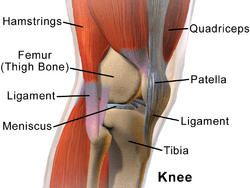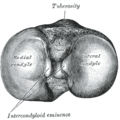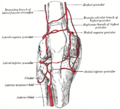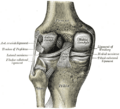Knee facts for kids
Quick facts for kids Knee |
|
|---|---|
 |
|
| Right knee seen from the right side | |
| Latin | Articulatio genus |
| System | Musculoskeletal system |
| Nerve | femoral, obturator, sciatic |
The knee is a super important joint in your body. It connects your thigh to your lower leg. It's actually made of two main joints! One connects your femur (thigh bone) to your tibia (shin bone). The other connects your femur to your kneecap (also called the patella).
Think of your knee like a special hinge joint. It lets you bend (this is called flexion) and straighten (this is called extension) your leg. It can also twist a little bit. Because it moves so much, your knee can sometimes get hurt or develop problems like osteoarthritis (a type of wear and tear).
Contents
How Your Knee Works
Your knee is held together by strong bands called ligaments. These ligaments connect the bones and keep them stable. The knee also makes a special fluid that helps the joint move smoothly, like oil in a machine.
The Meniscus: Your Knee's Shock Absorber
Inside your knee, there's a special type of cartilage called the meniscus. You have two menisci in each knee, one on the inner side and one on the outer side of your shin bone. These act like soft cushions or "shock absorbers" for your knee. They help spread out your body's weight evenly across the joint when you move.
Why the Knee is So Important
Your knee is the biggest and one of the most important joints in your body. It plays a huge role in how you move! It helps you carry your body weight when you're walking, running, or jumping. Without healthy knees, it would be very hard to do many everyday activities.
How the Kneecap Develops
When you are born, your kneecap (patella) isn't made of bone yet. It's just soft cartilage. This cartilage slowly turns into bone between the ages of three and five years old. The kneecap is the largest sesamoid bone in the human body. A sesamoid bone is a small, independent bone or nodule of cartilage developed in a tendon where it passes over an angular structure, typically in the hands and feet. Because it's a larger sesamoid bone, the process of it turning into hard bone takes a bit longer than other bones.
Images for kids
-
Radiography to examine eventual fractures after a knee injury
-
Hip-knee-ankle angle by age, with 95% prediction interval.
See also
 In Spanish: Articulación de la rodilla para niños
In Spanish: Articulación de la rodilla para niños











